July 8th, 2021
FBA Restock Limits Updated
Effective April 22, 2021
Amazon announced that effective April 22, 2021, FBA products will no longer be subject to ASIN-level quantity limits. Instead, restock limits will be set at the storage-type level. The goal for this change is to offer more flexibility to sellers when it comes to managing shipments.
A few points to note:
- Amazon states that the restock limits are based on past and forecasted sales.
- Your utilization is calculated by all of your incoming shipments that are in ‘working’, ‘transit’ or ‘receiving status’ and your current inventory levels at Amazon. Not included are your pending removals and reserved inventory.
To locate your restock limits:
- Sign into your Seller Central account.
- Go to ‘Inventory’ > ‘Manage FBA Shipments’.
- Scroll to the bottom of the page and click on the ‘Restock Limits’ tab.
FBA Fees 2021 - Fulfillment Fees, Storage Fees & Referral Fees
Effective June 1, 2021
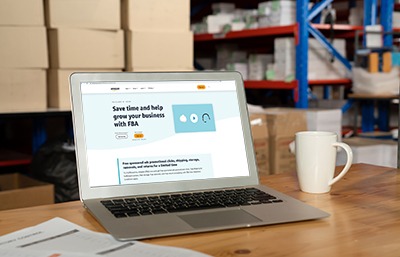 In 2020, Amazon did not sit idle. Instead they planned and expanded their fulfillment network by 50%. Worldwide they opened dozens of new delivery stations and fulfillment centers. Additionally, Amazon built more than 250 tools and services to assist Amazon sellers.
In 2020, Amazon did not sit idle. Instead they planned and expanded their fulfillment network by 50%. Worldwide they opened dozens of new delivery stations and fulfillment centers. Additionally, Amazon built more than 250 tools and services to assist Amazon sellers.
Every February it’s expected to see an FBA fee increase. However, this year, Amazon decided to postpone the increase until Spring 2021. They did this in an effort to help provide support to sellers as everyone continues to navigate the obstacles presented by COVID-19.
Starting June 1, 2021, sellers who use FBA will see new fees take effect. We highlight and review those FBA fees for 2021 below.
Most referral fees will not change and those that are changing have modest increases (2-3% on average). Certain fees, like the returns processing fee, will be reduced.
* Intended to be used and must be used for informational purposes only. Fees may be changed by Amazon at any time.
FBA Fees 2021 - Changes to Note
We wanted to call out a few of the more noteworthy changes, as we understand the detail and information below can be daunting at times.
- Amazon is launching FBA Liquidations, with associated fees for this service, which will allow sellers the opportunity to recover value from their overstock and returned items instead of having the inventory returned or disposed of.
- Amazon will eliminate the packaging weight adjustment to the rate card calculation. Amazon will no longer add an extra 0.5 lbs to each product’s weight to account for Amazon’s packaging.
- Amazon will increase removal and disposal fees to reflect the changing costs of these services.
- Amazon is increasing the FBA manual processing fee for shipments received without box content information to reflect the increasing cost of providing this service.
Detailed information about all of the Amazon FBA fee changes for 2021 can be found here. You will need to log into your seller account to view this information.
Always remember, if you are unsure and have questions, please reach out to our team. Your account manager and specialist will have the answers you need. If you don’t currently work with us, let’s jump on a call and we can figure out what next steps will work best for you.
Amazon Seller FBA Fees 2021
Fulfillment, Storage and Referral Fees
Effective June 1, 2021, unless otherwise noted.
Each year Amazon makes FBA fee changes relative to the changing market costs it experiences in providing fulfillment, transportation and customer services. This year, the FBA fee changes will apply to shipments leaving FBA fulfillment centers on or after June 1, 2021.
Fulfillment fees are what you pay to Amazon for returns and customer service, receiving your item, packaging it and sending it to a customer.
* Intended to be used and must be used for informational purposes only. Fees may be changed by Amazon at any time.
2021 FBA Fee Changes
(excludes apparel)

In the above table, sizes in the far left column are defined as follows:
- Small standard-size: packaged items weighing 16 oz. or less (there are two shipping weight options to choose from) with longest side equal to 15 inches or less, shortest side equal to 0.75 inches or less, median side = 12 inches or less
- Large standard-size: packaged items weighing 21 lb. or less (multiple shipping weight breakdowns) with its longest side equal to 18 inches or less, its shortest side equal to 8 inches or less, and its median side equal to 14 inches or less
- Small oversize: any packaged unit weighing 70 lb. or less with its longest side equal to 60 inches or less, its median side equal to 30 inches or less, and its longest side plus girth equal to 130 inches or less
- Medium oversize: any packaged unit weighing 150 lb. or less with its longest side equal to 108 inches or less, and its longest side plus girth equal to 130 inches or less
- Large oversize: any packaged unit weighing 150 lb. or less with its longest side equal to 108 inches or less, and its longest side plus girth equal to 165 inches or less
- Special oversize: any packaged unit with weight exceeding one or more of the following: over 150 lb. (dimensional weight or unit weight), exceeding 108 inches on its longest side, or over 165 inches when the longest side is added to girth. In addition, products that Amazon determines require special handling or delivery will qualify for Special Oversize
2021 FBA Fee Changes for Clothing
Amazon implemented the following fee changes for clothing items in the Clothing & Accessories category.
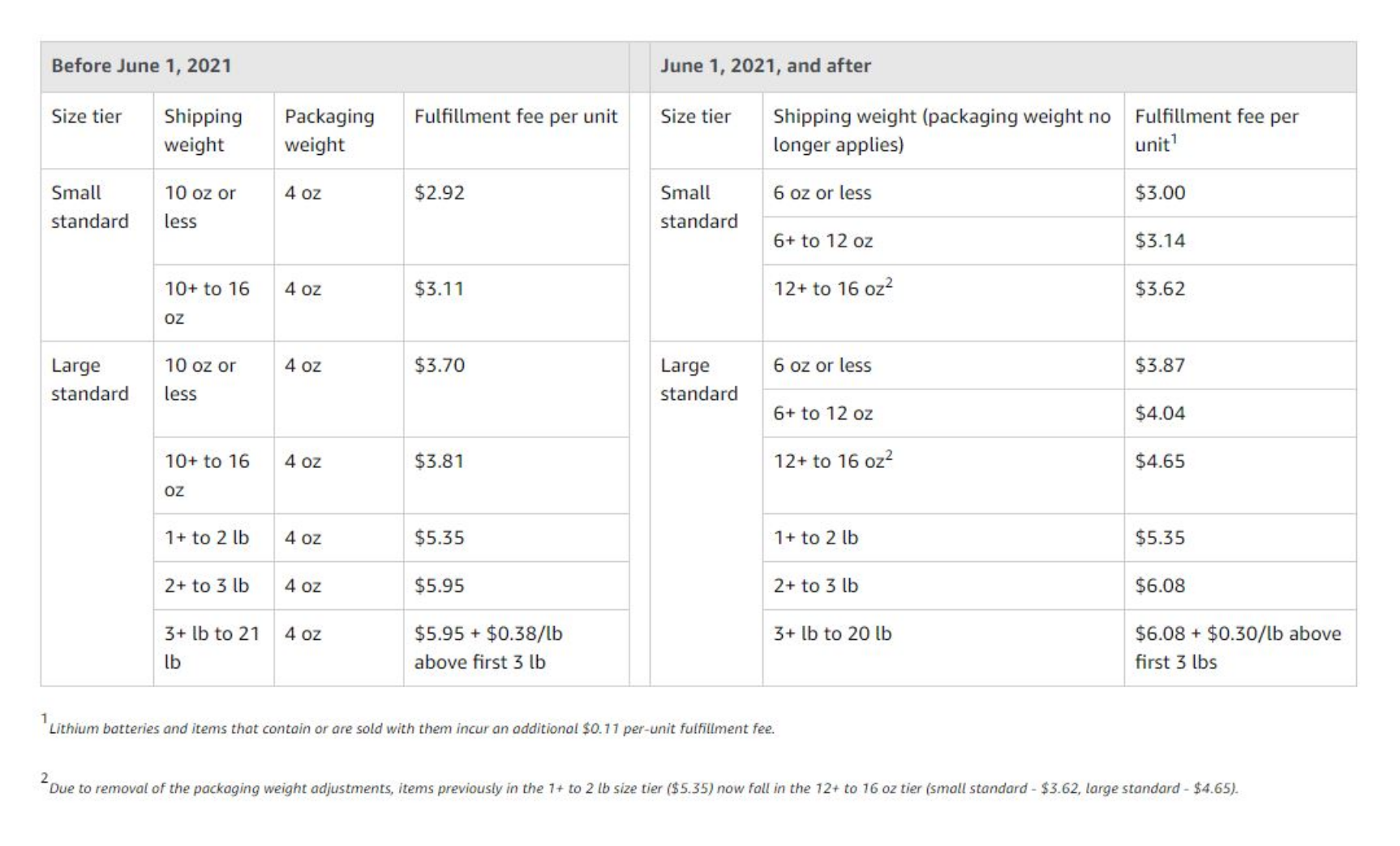
Note: Oversize clothing tiers (small oversize, medium oversize, large oversize and special oversize) will be charged the core FBA fulfillment fees.
2021 FBA Fee Changes for Dangerous Goods
FBA has separate fulfillment fees for dangerous goods (also known as hazardous materials or hazmat) that require special handling and storage. Note that Amazon no longer has separate fees for apparel and non-apparel dangerous goods.
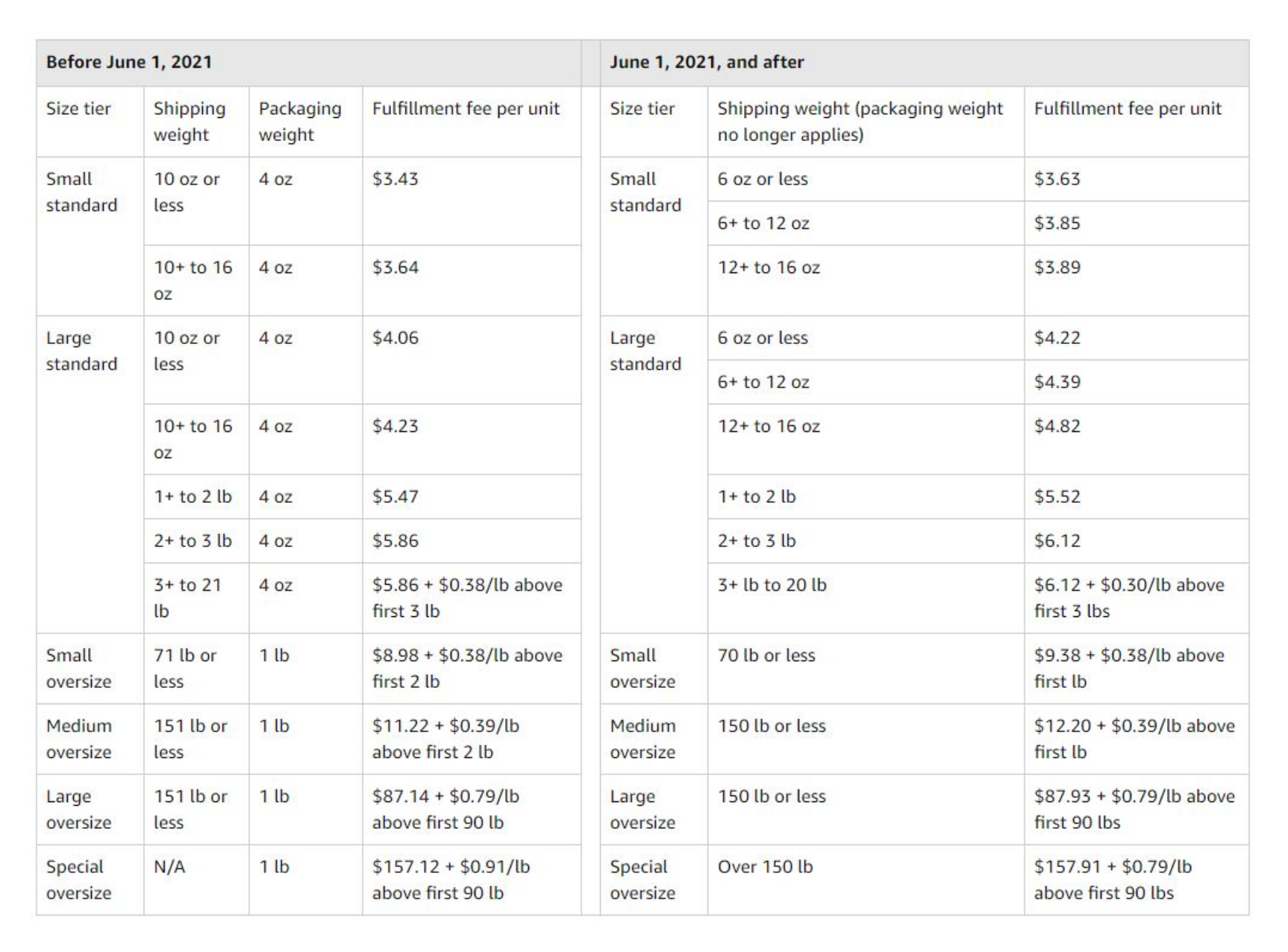
Returns Process Fees
This refers to the fees inquired from returns. Amazon will reduce the returns processing fee for customer-returned products in the Apparel and Shoes categories. They will also be eliminating the returns processing fee for customer-returned products in the Watches, Jewelry, Luggage, Handbags and Sunglasses categories.
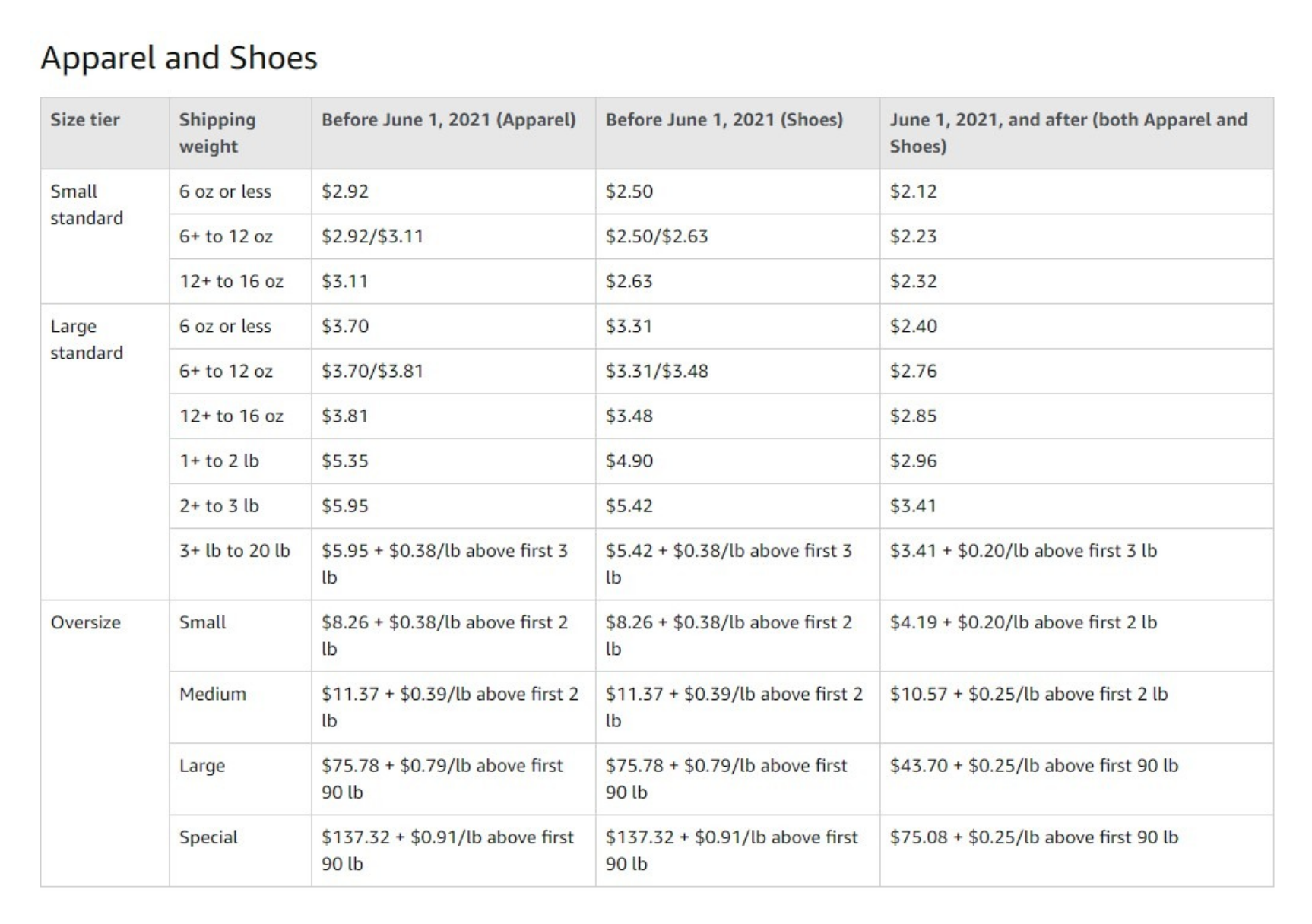
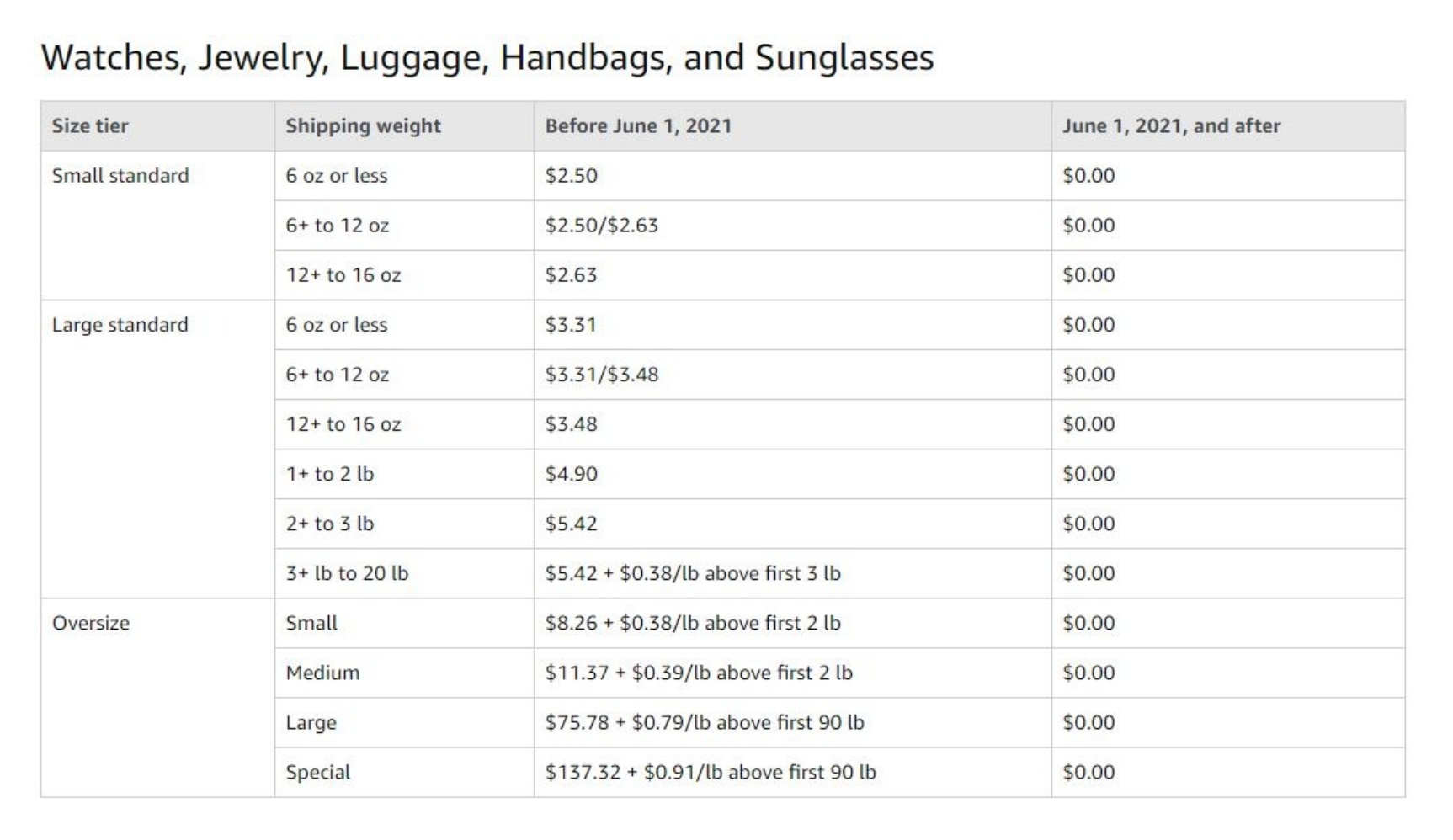
Removal, Disposals and Manuarl Processing Fees
The adjusted removal and disposal fees shown below will take effect on June 1, 2021.
FBA New Selection program offers minor fee breaks on storage, removals and returns for eligible new-to-FBA ASINs. This program has been around but now is more widely available.
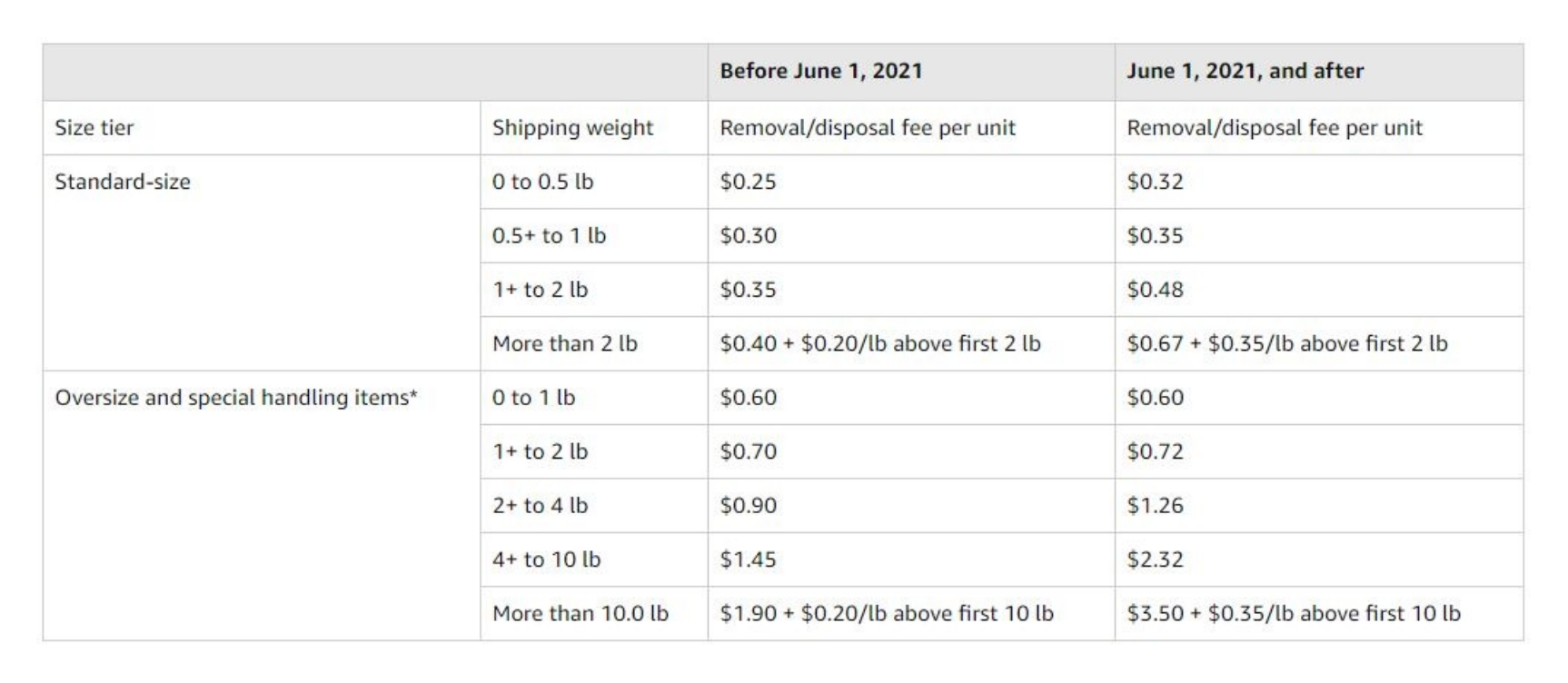

Small and Light Fees
A few points to note related to changes made for small standard and large standard sizes.
- The weight limit for Small and Light is increasing from 10 to 12 ounces.
- The size limit of the longer side is going from 16 to 18 inches. The median side from 9 to 14 inches. And the shortest side from 4 to 8 inches.
- Amazon will be eliminating the packaging weight adjustment to their rate card calculation.
- These product size tiers will align with the upcoming changes to core FBA for standard-size products 12 oz and below. This also will offer lower fulfillment fees compared to core FBA.
- If you enroll in the optional FBA Label Service for Small and Light items, Amazon will continue charging $0.10 per unit.
- Unless otherwise specified, Amazon will continue charging all other fees as core FBA.

Storage and Label Fees
This service is for eligible products that require an Amazon barcode. FBA can apply those barcodes for you for a per-item fee.
Products are eligible for this service if:
- Not prohibited, restricted or high-value items
- Have a single scannable barcode (GCID, UPC, EAM, JAN or ISBN) that corresponds to an ASIN in Amazon’s online catalog.
If there is not an eligible manufacturer barcode on the item, you must apply an Amazon barcode to the item yourself. The fee for FBA Label service is $0.30 per unit. For Small and Light, the fee is $0.10 per unit.